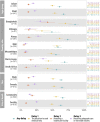Identifying delays in healthcare seeking and provision: The Three Delays-in-Healthcare and mortality among infants and children aged 1-59 months
- PMID: 38329969
- PMCID: PMC10852234
- DOI: 10.1371/journal.pgph.0002494
Identifying delays in healthcare seeking and provision: The Three Delays-in-Healthcare and mortality among infants and children aged 1-59 months
Abstract
Delays in illness recognition, healthcare seeking, and in the provision of appropriate clinical care are common in resource-limited settings. Our objective was to determine the frequency of delays in the "Three Delays-in-Healthcare", and factors associated with delays, among deceased infants and children in seven countries with high childhood mortality. We conducted a retrospective, descriptive study using data from verbal autopsies and medical records for infants and children aged 1-59 months who died between December 2016 and February 2022 in six sites in sub-Saharan Africa and one in South Asia (Bangladesh) and were enrolled in Child Health and Mortality Prevention Surveillance (CHAMPS). Delays in 1) illness recognition in the home/decision to seek care, 2) transportation to healthcare facilities, and 3) the receipt of clinical care in healthcare facilities were categorized according to the "Three Delays-in-Healthcare". Comparisons in factors associated with delays were made using Chi-square testing. Information was available for 1,326 deaths among infants and under 5 children. The majority had at least one identified delay (n = 854, 64%). Waiting >72 hours after illness recognition to seek health care (n = 422, 32%) was the most common delay. Challenges in obtaining transportation occurred infrequently when seeking care (n = 51, 4%). In healthcare facilities, prescribed medications were sometimes unavailable (n = 102, 8%). Deceased children aged 12-59 months experienced more delay than infants aged 1-11 months (68% vs. 61%, P = 0.018). Delays in seeking clinical care were common among deceased infants and children. Additional study to assess the frequency of delays in seeking clinical care and its provision among children who survive is warranted.
Copyright: This is an open access article, free of all copyright, and may be freely reproduced, distributed, transmitted, modified, built upon, or otherwise used by anyone for any lawful purpose. The work is made available under the Creative Commons CC0 public domain dedication.
Conflict of interest statement
I have read the journal’s policy and the authors of this manuscript have the following competing interests: CGW received honoraria from the University of St. Andrews for speaking to alumni about CHAMPS and global health work. JAGS reports receiving funding from the Wellcome Trust, UK FCDO, European Union, and the National Institute for Health Research. SM has received grants from the Bill & Melinda Gates Foundation, GSK, Pfizer, Minervax, Novavax, Providence, Gritstone, and ImmunityBio. SM has received honoraria from GSK for lecturing. CGW and SM report serving on data safety monitoring boards for SPEAC (CGW) and PATH and CAPRISA (SM). DT-F reports having received the support of a fellowship from “La Caixa” Foundation (ID 100010434, “LCF/BQ/DR21/11880018”). All other investigators declare no competing interests.
Figures





References
-
- UNICEF. Levels & Trends in Child Mortality Report 2022. 2022. https://data.unicef.org/resources/levels-and-trends-in-child-mortality/.
LinkOut - more resources
Full Text Sources
